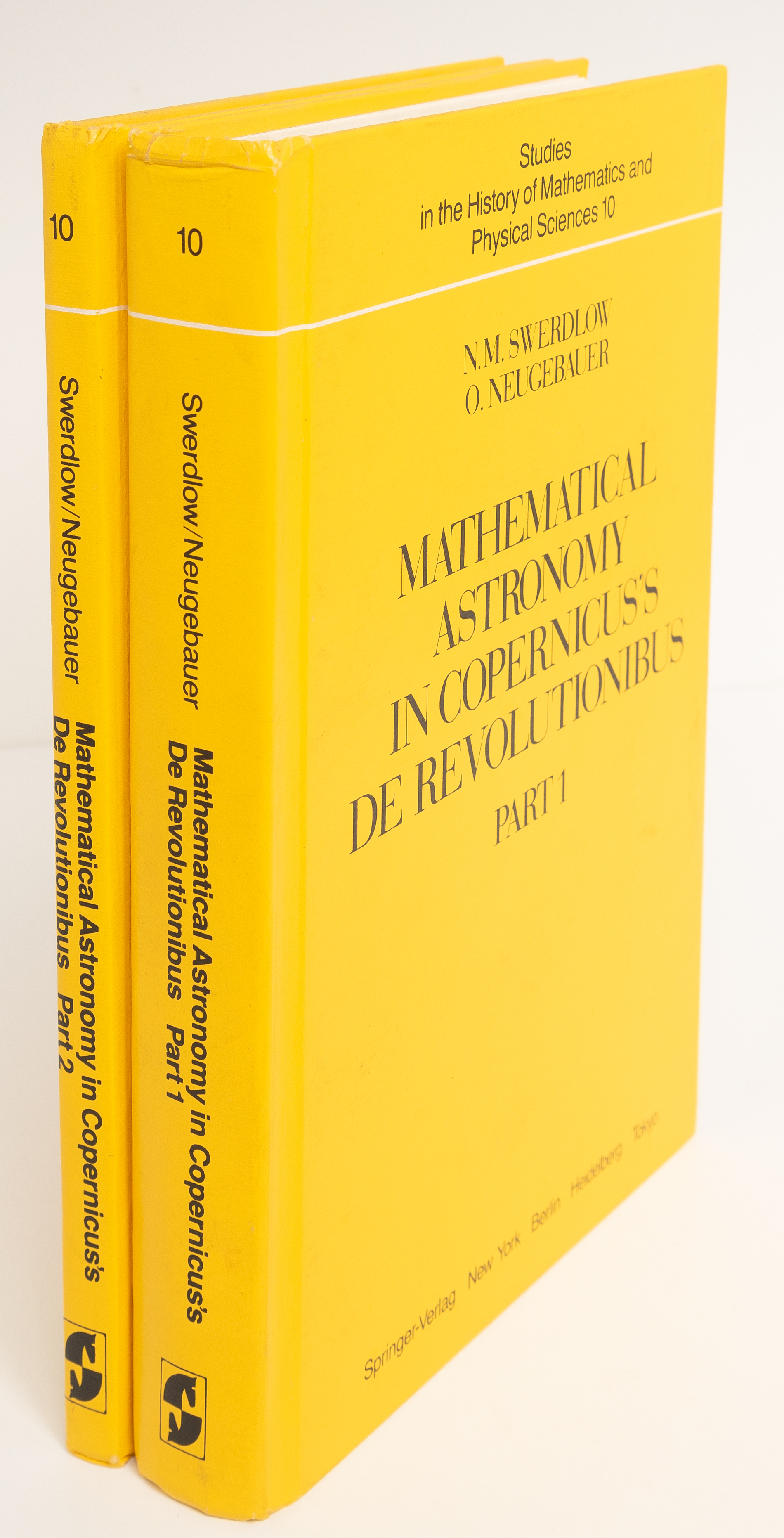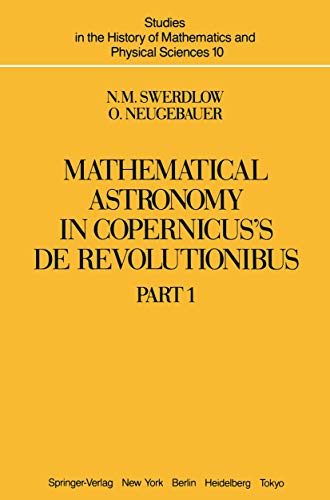
Mathematical Astronomy in Copernicus' de Revolutionibus by N. M., Neugebauer, O. Swerdlow - livre d'occasion
1975, ISBN: 9780387909394
When I first laid out the framework for A History of Ancient Mathe matical Astronomy, I intended to carry the discussion down to the last applications of Greek astronomical methodology, … Plus…
| BetterWorldBooks.com used in stock. Frais d'envoizzgl. Versandkosten., Livraison non-comprise Details... |

1984, ISBN: 9780387909394
Springer Verlag, Copertina rigida, Auflage: 1984 ed. 728 Seiten, Publiziert: 1984-07-02T00:00:01Z, Produktgruppe: Libro, Matematica, Scienze, tecnologia e medicina, Categorie, Libri, Astr… Plus…
| amazon.it Paper Cavalier Italia Frais d'envoiGeneralmente spedito entro 9-10 giorni. Le spese di spedizione possono differire dai costi effettivi. (EUR 2.90) Details... |

1984, ISBN: 0387909397
Edition reliée
[EAN: 9780387909394], Usato, ottimo stato, [SC: 69.62], [PU: Springer-Verlag, New York], Two volumes. First printings. 8vo. 711 pp. Very Good. Some wear to spine ends, lightest dust soili… Plus…
| AbeBooks.it Zed Books, New York, NY, U.S.A. [50068598] [Rating: 5 (su 5)] NOT NEW BOOK. Frais d'envoi EUR 69.62 Details... |

1984, ISBN: 9780387909394
New York: Springer-Verlag, 1984. Two volumes. First printings. 8vo. 711 pp. Very Good. Some wear to spine ends, lightest dust soiling to boards. First Edition. Hardcover. Very Good., Spri… Plus…
| Biblio.co.uk |

Mathematical Astronomy in Copernicus*s De Revolutionibus, 2 Volume Set (Studies in the History of Mathematics and the Physical Sciences, No. 10) - edition reliée, livre de poche
1984, ISBN: 0387909397
[EAN: 9780387909394], Used, good, [PU: Springer], Good, Books
| AbeBooks.com dsmbooks, liverpool, United Kingdom [61944145] [Rating: 4 (of 5)] NOT NEW BOOK. Frais d'envoi EUR 25.16 Details... |


Mathematical Astronomy in Copernicus' de Revolutionibus by N. M., Neugebauer, O. Swerdlow - livre d'occasion
1975, ISBN: 9780387909394
When I first laid out the framework for A History of Ancient Mathe matical Astronomy, I intended to carry the discussion down to the last applications of Greek astronomical methodology, … Plus…

Swerdlow, N. M. Neugebauer, O.:
Mathematical Astronomy in Copernicus's De Revolutionibus: In Two Parts - livre d'occasion1984, ISBN: 9780387909394
Springer Verlag, Copertina rigida, Auflage: 1984 ed. 728 Seiten, Publiziert: 1984-07-02T00:00:01Z, Produktgruppe: Libro, Matematica, Scienze, tecnologia e medicina, Categorie, Libri, Astr… Plus…

1984
ISBN: 0387909397
Edition reliée
[EAN: 9780387909394], Usato, ottimo stato, [SC: 69.62], [PU: Springer-Verlag, New York], Two volumes. First printings. 8vo. 711 pp. Very Good. Some wear to spine ends, lightest dust soili… Plus…
1984, ISBN: 9780387909394
New York: Springer-Verlag, 1984. Two volumes. First printings. 8vo. 711 pp. Very Good. Some wear to spine ends, lightest dust soiling to boards. First Edition. Hardcover. Very Good., Spri… Plus…

Données bibliographiques du meilleur livre correspondant
Informations détaillées sur le livre - Mathematical Astronomy in Copernicus's De Revolutionibus: In Two Parts
EAN (ISBN-13): 9780387909394
ISBN (ISBN-10): 0387909397
Version reliée
Livre de poche
Date de parution: 1984
Editeur: Springer Verlag
Livre dans la base de données depuis 2007-06-01T23:23:41+02:00 (Paris)
Page de détail modifiée en dernier sur 2023-12-10T14:08:41+01:00 (Paris)
ISBN/EAN: 0387909397
ISBN - Autres types d'écriture:
0-387-90939-7, 978-0-387-90939-4
Autres types d'écriture et termes associés:
Auteur du livre: otto neugebauer noel swerdlow, nicolaus copernicus
Titre du livre: copernicus, revolutionibus, history science part, mathematical astronomy, mathematics and history, history physical astronomy, history mathematical sciences, the history mathematics
Données de l'éditeur
Auteur: N.M. Swerdlow; O. Neugebauer
Titre: Studies in the History of Mathematics and Physical Sciences; Mathematical Astronomy in Copernicus’ De Revolutionibus - In Two Parts
Editeur: Springer; Springer US
711 Pages
Date de parution: 1984-07-02
New York; NY; US
Poids: 1,390 kg
Langue: Anglais
85,55 € (DE)
87,95 € (AT)
106,60 CHF (CH)
Not available, publisher indicates OP
BB; Book; Hardcover, Softcover / Mathematik; Mathematik; Verstehen; Astronomy; Calculation; Copernicus; theorem; equation; Derivation; B; Mathematics, general; Mathematics and Statistics; BC; EA
1. General Introduction.- 1. Life of Nicolaus Copernicus.- Chronology of Copernicus’s Life.- 2. The Astronomy of Copernicus.- Ptolemy’s Astronomy in the Almagest and the Planetary Hypotheses.- Arabic Astronomy and the Mar?gha School.- European Astronomy and Regiomontanus.- Early Period to the Writing of the Commentariolus.- The Years of Observation.- De revolutionibus.- Conclusions.- 3. Texts, Editions, and Translations.- The Text of De revolutionibus.- Note on the Dating of M.- Editions and Translations.- Editions of Copernicus’s Sources.- Purpose and Limitations of This Study.- 2. Trigonometry and Spherical Astronomy.- 1. Trigonometry (1,12–14).- 2. Spherical Astronomy.- Obliquity of the Ecliptic (II,2).- Ecliptic and Equatorial Coordinates (II,3–4).- Shadow Lengths (II,6).- Length of Daylight and Ascensional Corrections (II,7–8).- Oblique Ascension and Applications of Right and Oblique Ascension (II,9,11).- Intersection of Ecliptic with Horizon and Circles of Altitude (II,10,12).- 3. Risings and Settings (II,13).- 4. The Catalogue of Stars (II,14).- 3. The Motions of the Earth.- 1. Precession and Variation of Obliquity.- Statement of the Problem (III,1).- The Observational Record (III,2).- The Model (III,3-5).- Derivation of Parameters (III,6-7,9-11).- (a) The Anomaly of the Obliquity and Precession: ? and 2? (III,6).- (b) The Mean Precession: \\[\\overline \\pi \\] (III,6).- (c) The Maximum Equation of Precession: ?Pmax (III,7).- (d) Correction of the Location of ?= 0° (III,9).- (e) Limits of the Obliquity: ?min and ?max (III, 10).- (f) Epoch Positions of the Mean Precession and Anomaly: \\[\\overline \\pi \\]0 and ?0 (III,11).- The Tables and Their Use (III,6,8,12).- Verification of Precession and Obliquity.- 2. Solar Theory.- The Inequality of the Tropical Year (III, 13).- The Model for the First Inequality (III, 15).- Derivation of Eccentricity and Direction of the Apsidal Line (III,16–17).- Mean Motion, Length of Sidereal Year, Positions at Epoch (III,18–19).- The Mean Tropical Year and Mean Rate of Precession.- The Model for the Second Inequality (III,20).- Variation of the Eccentricity and Equation of the Apsidal Line (III,21).- Mean Motion of the Apogee (III,22).- Positions at Epoch (III, 19,23).- Remarks on the Second Inequality.- The Tables and Their Use (III,14,24,25).- Verification of the Solar Theory.- 3. The Equation of Time (III,26).- Supplementary Remark: The Quantity and Location of (? — ?)max.- Appendix: Copernicus’s Chronology and Geography.- Chronology.- Geography.- 4. Lunar Theory and Related Subjects.- 1. The Lunar Theory.- The Problems of Ptolemy’s Lunar Model (IV, 1–2).- Copernicus’s Model (IV,3).- Preliminary Mean Motions (IV,4).- Observations of the Moon.- The First Inequality (IV,5).- 1. Ptolemy’s Derivation.- 2. Copernicus’s Derivation.- Correction of Mean Elongation and Anomaly (IV,6).- Mean Elongation and Anomaly at Epoch (IV,7).- The Second Inequality (IV,8–9).- Effect of the Second Inequality at Syzygy.- Trigonometric Computation of a Lunar Position (IV, 10).- Correction of the Mean Argument of Latitude (IV, 13).- Mean Argument of Latitude at Epoch (IV, 14).- The Tables and Their Use (IV,4,11,12).- Verification of the Lunar Theory.- 2. The Parallax and Apparent Diameter of the Sun and Moon.- Parallax of the Moon (IV,15–16).- Comment.- Distance of the Moon (IV, 17).- Hypothetical Determination of the Apparent Diameter of the Moon and Shadow (IV,18).- Solar Distance and Related Topics (IV, 19–20)..- 1. Ptolemy’s Demonstration.- 2. Al-Batt?n?’s Demonstration.- 3. Copernicus’s Demonstration.- Parallax and Apparent Diameter of the Sun (IV,21).- Parallax and Apparent Diameter of the Moon (IV,22).- Variation of the Shadow (IV,23).- Table of Apparent Semidiameters.- Table of Parallax and Its Use (IV,24–25).- Resolution of the Components of Parallax in Longitude and Latitude (IV,26).- Test of the Lunar Parallax (IV,27).- Comment.- 3. The Theory of Eclipses.- Mean Conjunction and Opposition (IV,28).- True Conjunction and Opposition (IV,29).- Distinction of Ecliptic Syzygies (IV,30).- Eclipse Magnitudes (IV,31).- Phases and Duration of Eclipses (IV,32).- 5. Planetary Theory of Longitude.- 1. General Considerations.- Model for the Second Anomaly (V,3).- The Problem of the First Anomaly (V,2).- Model for the First Anomaly (V,4).- The Equation of Center.- Transformations of the Complete Model and Technical Terms.- Mean Motions (V,l).- 2. The Derivation of the Elements of the Orbits of the Superior Planets.- Observations of the Superior Planets.- 1. Apparent and Mean Motion Between Oppositions.- 2. Solution for the Double Eccentricity and the Mean Eccentric Anomaly.- 3. Test of the Derived Elements.- 4. Correction of ? to ?’.- 5. Iteration.- 6. Mean Anomaly, Mean Longitude, and Longitude of Apogee.- 7. Correction of the Mean Anomaly and Positions at Epoch.- 8. Distance of the Planet and Equation of the Anomaly.- 3. The Individual Planets.- A. Saturn.- Observations.- Review of Ptolemy’s Derivation (V,5).- Copernicus’s Derivation (V,6).- Correction of the Mean Anomaly and Positions at Epoch (V,7–8).- Distance and Equation of the Anomaly (V,9).- B. Jupiter.- Observations.- Review of Ptolemy’s Derivation (V, 10).- Copernicus’s Derivation (V, 11).- Correction of the Mean Anomaly and Positions at Epoch (V,12–13).- Distance and Equation of the Anomaly (V, 14).- C. Mars.- Observations.- Review of Ptolemy’s Derivation (V,15).- Copernicus’s Derivation (V, 16).- Reduction and Division of the Eccentricity.- Correction of the Mean Anomaly and Positions at Epoch (V,17–18).- Distance and Equation of the Anomaly (V, 19).- Conclusion to the Superior Planets.- 4. The Inferior Planets.- A. Venus.- Development of the Model.- Observations.- Supplementary Remark: The Date of Observation (3).- Longitude of the Apsidal Line (V,20).- Radius of Orbit and Eccentricities (V,21–22).- Reduction of the Eccentricity from “Many Observations”.- Correction of the Mean Anomaly and Positions at Epoch (V, 23–24).- 2. Revised Version.- 2. Original Version.- B. Mercury.- Development of the Models (V,25,32).- Observations.- Longitude of the Apsidal Line (V,26).- Radius of Orbit and Eccentricities (V,27).- Elongations at $$ \\overline {\\text{K}} $$ = ± 120° (V,28).- Comparison of Equations and Elongations in the Models of Ptolemy and Copernicus.- Correction of the Mean Anomaly and Positions at Epoch (V,29–31).- 1. Ancient Observation (V,29).- 2. Modern Observations (V,30).- Comment.- 3. Corrected Mean Anomaly and Positions at Epoch (V,30–31).- Conclusions to the Planets.- 5. The Tables and Their Use.- Arrangement and Computation of the Tables (V, 1,33).- Numerical Evaluation of the Correction Tables.- Calculation of Longitudes from the Tables (V,34).- Verification of the Planetary Theory.- 1. Superior Planets.- 2. Inferior Planets.- 6. Stations and Retrogradations.- Apollonius’s Theorem (V,35).- Application of Apollonius’s Theorem (V,36).- Original Version of V,36.- Appendix: The Distances of the Planets and Cosmology.- 6. Planetary Theory of Latitude.- General Considerations.- 1. Superior Planets.- Development of the Model (VI, 1–2).- Derivation of Parameters (VI,3).- Computation from the Model (VI,4).- 2. Inferior Planets.- Development of the Model (VI, 1–2).- Note on Technical Terms.- Derivation of Parameters and Computation from the Model.- A. Inclination, ?1 and i1 (VI,5).- B. Slant, ?2 and i2 (VI,6–7).- C. Deflection, ?3 and i3 (VI,8).- 3. The Tables and Their Use (VI,9).- 5. Superior Planets.- 5. Inferior Planets.- Correct Computation of ?1 and ?2 from Copernicus’s Model.- Concluding Remarks.Autres livres qui pourraient ressembler au livre recherché:
Dernier livre similaire:
9781461382621 Mathematical Astronomy in Copernicus' De Revolutionibus (N. M. Swerdlow/ O. Neugebauer)
- 9781461382621 Mathematical Astronomy in Copernicus' De Revolutionibus (N. M. Swerdlow/ O. Neugebauer)
- 9781461382645 Mathematical Astronomy in Copernicus' De Revolutionibus: Part 1-2 (Studies in the History of Mathematics and Physical Sciences): In Two Parts (Studies ... and Physical Sciences, 10, Band 10) (Swerdlow, N. M.)
- 9783540909392 Mathematical Astronomy in Copernicus' De Revolutionibus, 2 Vols. (Swerdlow, N. M. Neugebauer, Otto)
- Mathematical Astronomy in Copernicus' De Revolutionibus (N.M. Swerdlow, O. Neugebauer)
< pour archiver...

